On the Performance of Energy Criterion Method in Wi-Fi Transient Signal Detection
Abstract
:1. Introduction
1.1. Related Works
1.2. Aim of the Study and Contributions
- (a)
- This is the first report that studies the validity of the EC- method using large sets of Wi-Fi signals captured from various Wi-Fi devices;
- (b)
- By utilizing the large sets of Wi-Fi signals under different SNR levels, the transient start detection performance of the well-known methods is comparatively assessed for the first time in the literature.
2. Data Acquisition
2.1. System Setup and Wi-Fi Signal Capturing
2.2. Preprocessing
3. Energy Criterion Method Based on the Instantaneous Amplitude Characteristics
4. Experimental Results and Discussion
5. Conclusions
Author Contributions
Funding
Institutional Review Board Statement
Informed Consent Statement
Data Availability Statement
Conflicts of Interest
References
- Bai, L.; Zhu, L.; Liu, J.; Choi, J.; Zhang, W. Physical Layer Authentication in Wireless Communication Networks: A Survey. J. Commun. Inf. Netw. 2020, 5, 237–264. [Google Scholar]
- Ureten, O.; Serinken, N. Wireless Security through RF Fingerprinting. Can. J. Electr. Comput. Eng. 2007, 32, 27–33. [Google Scholar] [CrossRef]
- Soltanieh, N.; Norouzi, Y.; Yang, Y.; Karmakar, N.C. A Review of Radio Frequency Fingerprinting Techniques. IEEE J. Radio Freq. Identif. 2020, 4, 222–233. [Google Scholar] [CrossRef]
- Uzundurukan, E.; Dalveren, Y.; Kara, A. A Database for the Radio Frequency Fingerprinting of Bluetooth Devices. Data 2020, 5, 55. [Google Scholar] [CrossRef]
- Uzundurukan, E.; Ali, A.M.; Dalveren, Y.; Kara, A. Performance Analysis of Modular RF Front End for RF Fingerprinting of Bluetooth Devices. Wirel. Pers. Commun. 2020, 112, 2519–2531. [Google Scholar] [CrossRef]
- Suski, W.C., II; Temple, M.A.; Mendenhall, M.J.; Mills, R.F. Using Spectral Fingerprints to Improve Wireless Network Security. In Proceedings of the IEEE GLOBECOM 2008–2008 IEEE Global Telecommunications Conference, New Orleans, LO, USA, 30 November–4 December 2008; IEEE: Piscataway, NJ, USA, 2008; pp. 1–5. [Google Scholar]
- Klein, R.W.; Temple, M.A.; Mendenhall, M.J. Application of Wavelet Denoising to Improve OFDM-Based Signal Detection and Classification. Secur. Commun. Netw. 2010, 3, 71–82. [Google Scholar] [CrossRef]
- Kennedy, I.O.; Scanlon, P.; Buddhikot, M.M. Passive Steady State Rf Fingerprinting: A Cognitive Technique for Scalable Deployment of Co-Channel Femto Cell Underlays. In Proceedings of the 2008 3rd IEEE Symposium on New Frontiers in Dynamic Spectrum Access Networks, Chicago, IL, USA, 14–17 October 2008; IEEE: Piscataway, NJ, USA, 2008; pp. 1–12. [Google Scholar]
- Scanlon, P.; Kennedy, I.O.; Liu, Y. Feature Extraction Approaches to RF Fingerprinting for Device Identification in Femtocells. Bell Labs Tech. J. 2010, 15, 141–151. [Google Scholar] [CrossRef]
- Kennedy, I.O.; Scanlon, P.; Mullany, F.J.; Buddhikot, M.M.; Nolan, K.E.; Rondeau, T.W. Radio Transmitter Fingerprinting: A Steady State Frequency Domain Approach. In Proceedings of the 2008 IEEE 68th Vehicular Technology Conference, Calgary, AB, Canada, 21–24 September 2008; IEEE: Piscataway, NJ, USA, 2008; pp. 1–5. [Google Scholar]
- Rehman, S.U.; Sowerby, K.; Coghill, C. Analysis of Receiver Front End on the Performance of Rf Fingerprinting. In Proceedings of the 2012 IEEE 23rd International Symposium on Personal, Indoor and Mobile Radio Communications-(PIMRC), Sydney, NSW, Australia, 9–12 September 2012; IEEE: Piscataway, NJ, USA, 2012; pp. 2494–2499. [Google Scholar]
- Rehman, S.U.; Sowerby, K.W.; Coghill, C. Radio-Frequency Fingerprinting for Mitigating Primary User Emulation Attack in Low-End Cognitive Radios. IET Commun. 2014, 8, 1274–1284. [Google Scholar] [CrossRef]
- Brik, V.; Banerjee, S.; Gruteser, M.; Oh, S. Wireless Device Identification with Radiometric Signatures. In Proceedings of the 14th ACM International Conference on Mobile Computing and Networking, San Francisco, CA, USA, 14–19 September 2008; pp. 116–127. [Google Scholar]
- Klein, R.W.; Temple, M.A.; Mendenhall, M.J. Application of Wavelet-Based RF Fingerprinting to Enhance Wireless Network Security. J. Commun. Netw. 2009, 11, 544–555. [Google Scholar] [CrossRef]
- Williams, M.D.; Munns, S.A.; Temple, M.A.; Mendenhall, M.J. RF-DNA Fingerprinting for Airport WiMax Communications Security. In Proceedings of the 2010 Fourth International Conference on Network and System Security, Melbourne, VIC, Australia, 1–3 September 2010; IEEE: Piscataway, NJ, USA, 2010; pp. 32–39. [Google Scholar]
- Danev, B.; Heydt-Benjamin, T.S.; Capkun, S. Physical-Layer Identification of RFID Devices. In Proceedings of the USENIX Security Symposium, 10–14 August 2009; pp. 199–214. [Google Scholar]
- Shi, Y.; Jensen, M.A. Improved Radiometric Identification of Wireless Devices Using MIMO Transmission. IEEE Trans. Inf. Forensics Secur. 2011, 6, 1346–1354. [Google Scholar] [CrossRef]
- Toonstra, J.; Kinsner, W. Transient Analysis and Genetic Algorithms for Classification. In Proceedings of the IEEE WESCANEX 95. Communications, Power, and Computing. Conference Proceedings, Winnipeg, MB, Canada, 15–16 May 1995; IEEE: Piscataway, NJ, USA, 1995; Volume 2, pp. 432–437. [Google Scholar]
- Choe, H.C.; Poole, C.E.; Andrea, M.Y.; Szu, H.H. Novel Identification of Intercepted Signals from Unknown Radio Transmitters. In Proceedings of the Wavelet Applications II; International Society for Optics and Photonics, Orlando, FL, USA, 6 April 1995; Volume 2491, pp. 504–517. [Google Scholar]
- Hippenstiel, R.D.; Payal, Y. Wavelet Based Transmitter Identification. In Proceedings of the Fourth International Symposium on Signal Processing and Its Applications, Gold Coast, QLD, Australia, 25–30 August 1996; IEEE: Piscataway, NJ, USA; Volume 2, pp. 740–742. [Google Scholar]
- Ellis, K.J.; Serinken, N. Characteristics of Radio Transmitter Fingerprints. Radio Sci. 2001, 36, 585–597. [Google Scholar] [CrossRef]
- Tekbas, O.H.; Serinken, N.; Ureten, O. An Experimental Performance Evaluation of a Novel Radio-Transmitter Identification System under Diverse Environmental Conditions. Can. J. Electr. Comput. Eng. 2004, 29, 203–209. [Google Scholar] [CrossRef]
- Tekbas, O.H.; Ureten, O.; Serinken, N. Improvement of Transmitter Identification System for Low SNR Transients. Electron. Lett. 2004, 40, 182–183. [Google Scholar] [CrossRef]
- Barbeau, M.; Hall, J.; Kranakis, E. Detection of Rogue Devices in Bluetooth Networks Using Radio Frequency Fingerprinting. In Proceedings of the 3rd IASTED International Conference on Communications and Computer Networks, CCN, Lima, Peru, 28–30 August 2006; IASTED: Calgary, AB, Canada; Palma de Mallorca, Spain; pp. 4–6. [Google Scholar]
- Rasmussen, K.B.; Capkun, S. Implications of Radio Fingerprinting on the Security of Sensor Networks. In Proceedings of the 2007 Third International Conference on Security and Privacy in Communications Networks and the Workshops-SecureComm 2007, Nice, France, 17–21 September 2007; IEEE: Piscataway, NJ, USA, 2007; pp. 331–340. [Google Scholar]
- Danev, B.; Capkun, S. Transient-Based Identification of Wireless Sensor Nodes. In Proceedings of the 2009 International Conference on Information Processing in Sensor Networks, San Francisco, CA, USA, 13–16 April 2009; IEEE: Piscataway, NJ, USA, 2009; pp. 25–36. [Google Scholar]
- Ali, A.M.; Uzundurukan, E.; Kara, A. Assessment of Features and Classifiers for Bluetooth RF Fingerprinting. IEEE Access 2019, 7, 50524–50535. [Google Scholar] [CrossRef]
- Aghnaiya, A.; Ali, A.M.; Kara, A. Variational Mode Decomposition-Based Radio Frequency Fingerprinting of Bluetooth Devices. IEEE Access 2019, 7, 144054–144058. [Google Scholar] [CrossRef]
- Aghnaiya, A.; Dalveren, Y.; Kara, A. On the Performance of Variational Mode Decomposition-Based Radio Frequency Fingerprinting of Bluetooth Devices. Sensors 2020, 20, 1704. [Google Scholar] [CrossRef] [Green Version]
- Shaw, D.; Kinsner, W. Multifractal Modelling of Radio Transmitter Transients for Classification. In Proceedings of the IEEE WESCANEX 97 Communications, Power and Computing. Conference Proceedings, Winnipeg, MB, Canada, 22–23 May 1997; pp. 306–312. [Google Scholar]
- Ureten, O.; Serinken, N. Detection of Radio Transmitter Turn-on Transients. Electron. Lett. 1999, 35, 1996–1997. [Google Scholar] [CrossRef]
- Hall, J.; Barbeau, M.; Kranakis, E. Detection of Transient in Radio Frequency Fingerprinting Using Signal Phase. In Proceedings of the Third IASTED International Conference on Wireless and Optical Communications, Banff, AL, Canada, 14–16 July 2003; ACTA Press: Calgary, AB, Canada, 2003; pp. 13–18. [Google Scholar]
- Ureten, O.; Serinken, N. Bayesian Detection of Wi-Fi Transmitter RF Fingerprints. Electron. Lett. 2005, 41, 373–374. [Google Scholar] [CrossRef] [Green Version]
- Huang, L.; Gao, M.; Zhao, C.; Wu, X. Detection of Wi-Fi Transmitter Transients Using Statistical Method. In Proceedings of the 2013 IEEE International Conference on Signal Processing, Communication and Computing (ICSPCC 2013), Kunming, China, 5–8 August 2013; IEEE: Piscataway, NJ, USA, 2013; pp. 1–5. [Google Scholar]
- Yuan, Y.-J.; Wang, X.; Huang, Z.-T.; Sha, Z.-C. Detection of Radio Transient Signal Based on Permutation Entropy and GLRT. Wirel. Pers. Commun. 2015, 82, 1047–1057. [Google Scholar] [CrossRef]
- Mohamed, I.S.; Dalveren, Y.; Kara, A. Performance Assessment of Transient Signal Detection Methods and Superiority of Energy Criterion (EC) Method. IEEE Access 2020, 8, 115613–115620. [Google Scholar] [CrossRef]
- Higuchi, T. Approach to an Irregular Time Series on the Basis of the Fractal Theory. Phys. D Nonlinear Phenom. 1988, 31, 277–283. [Google Scholar] [CrossRef]
- Zhao, C.; Chi, T.-Y.; Huang, L.; Yao, Y.; Kuo, S.-Y. Wireless Local Area Network Cards Identification Based on Transient Fingerprinting. Wirel. Commun. Mob. Comput. 2013, 13, 711–718. [Google Scholar] [CrossRef]
- Markalous, S.M.; Tenbohlen, S.; Feser, K. Detection and Location of Partial Discharges in Power Transformers Using Acoustic and Electromagnetic Signals. IEEE Trans. Dielectr. Electr. Insul. 2008, 15, 1576–1583. [Google Scholar] [CrossRef]
- Herold, C.; Leibfried, T.; Markalous, S.; Quint, I. Algorithms for Automated Arrival Time Estimation of Partial Discharge Signals in Power Cables. In Proceedings of the 15th International Symposium on High Voltage Engineering, Ljubljana, Slovenia, 27–31 August 2007; pp. 1–5. [Google Scholar]
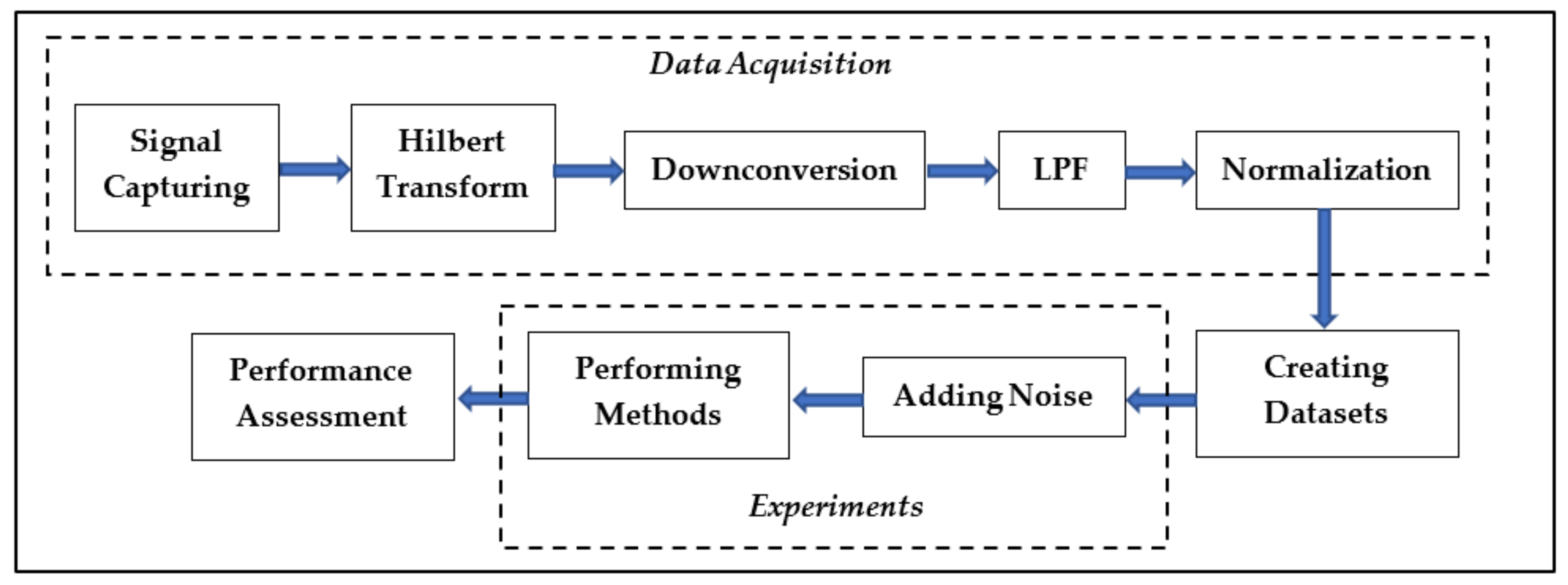
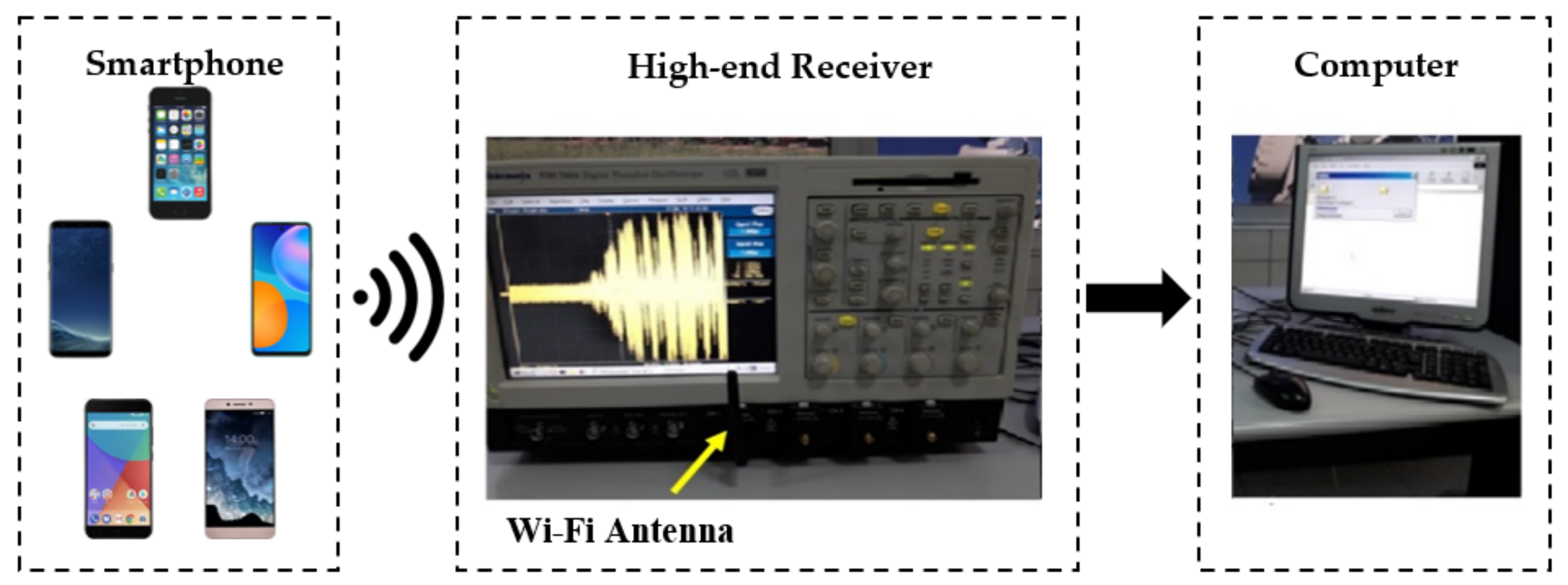
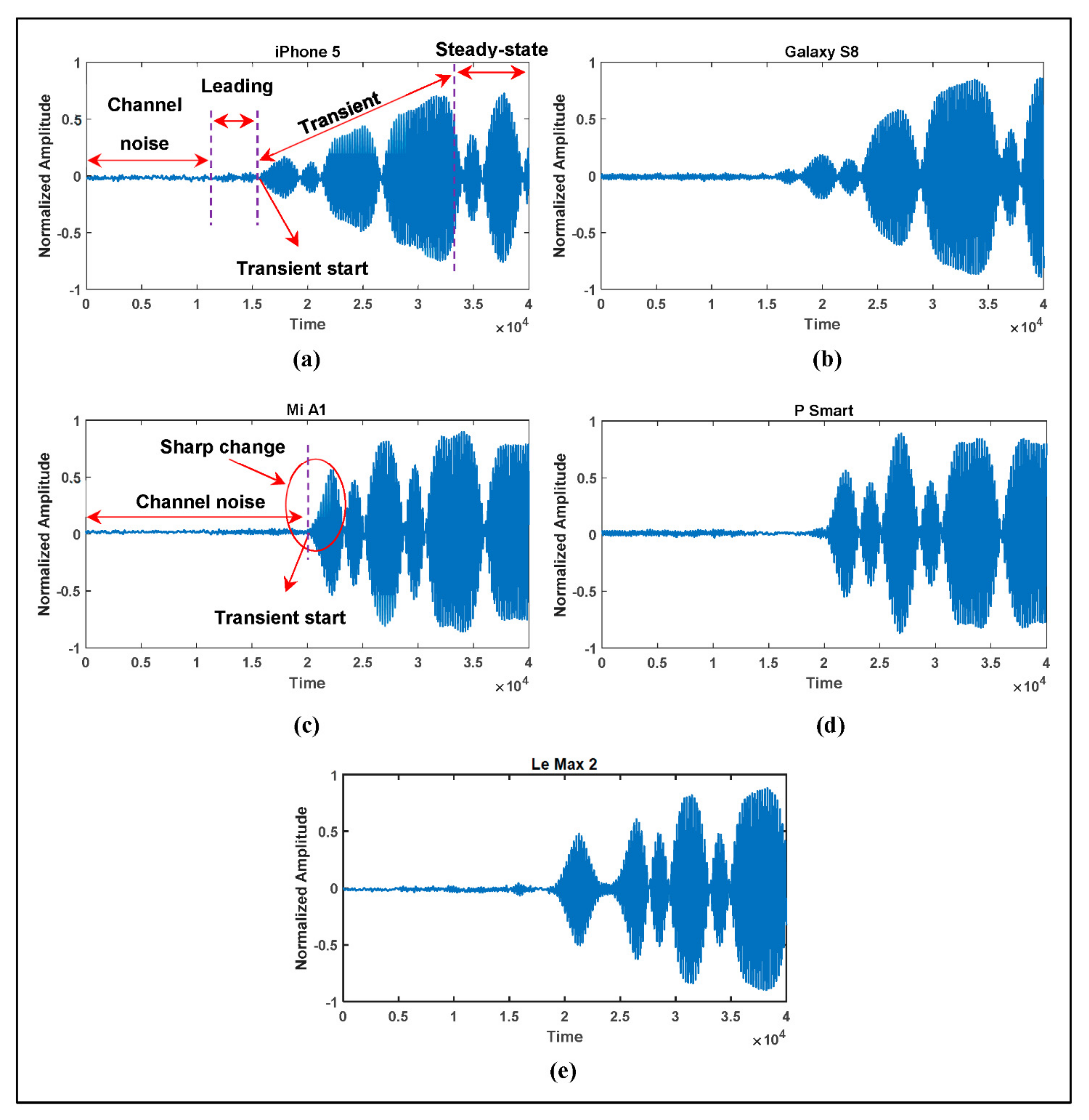


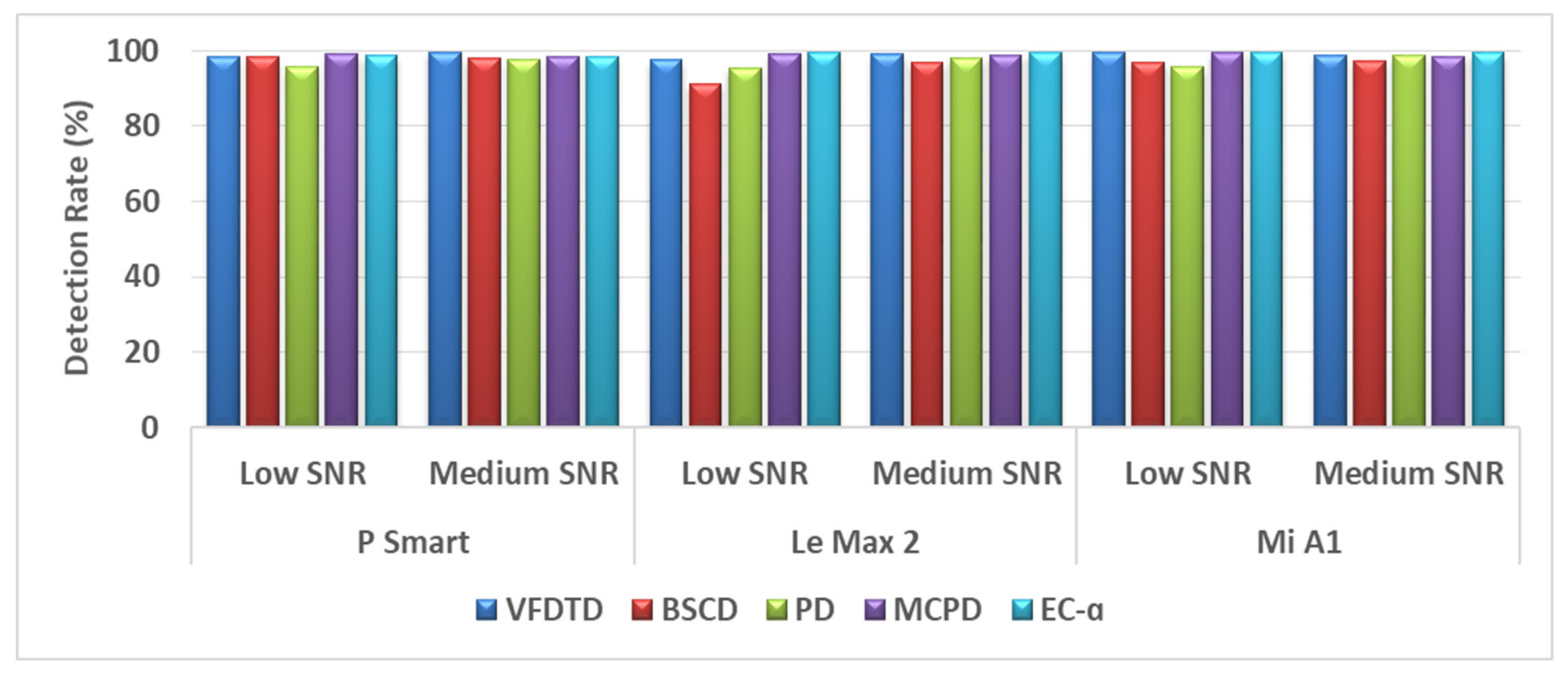

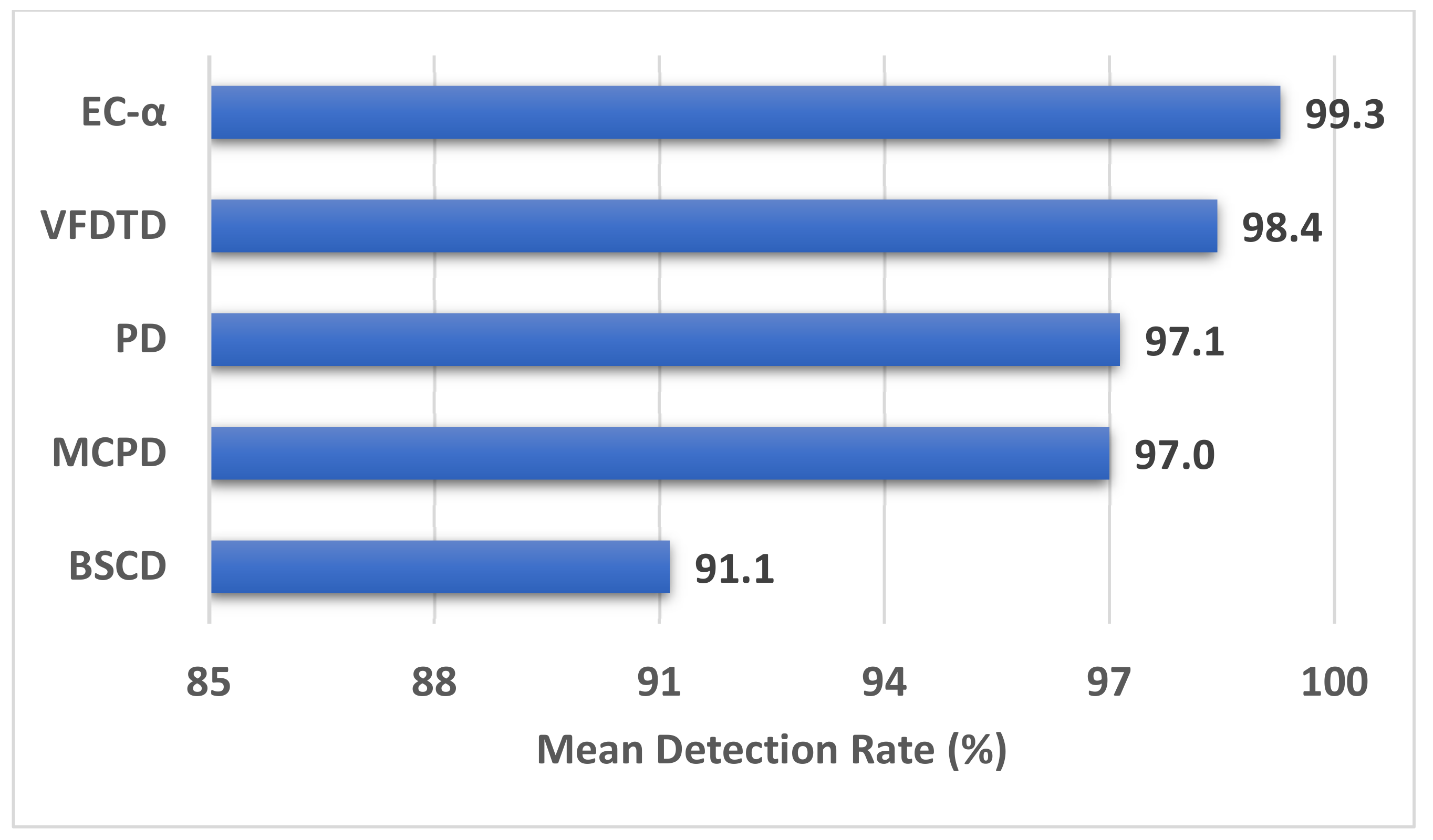

| Method | Signal Type | Number of Devices | SNR | Advantages | Disadvantages |
|---|---|---|---|---|---|
| VFDTD [30] | Radio | 8 (Radio transmitter) | NA |
|
|
| BSCD [31] | Radio | 30 (Radio transmitter) | NA |
|
|
| PD [32] | Bluetooth | 10 (Radio transmitter) | NA |
|
|
| BRCD [33] | 802.11b Wi-Fi | 9 (Wi-Fi radio) | NA |
|
|
| MCPD [34] | Wi-Fi | 6 (WLAN card) | 6 to 30 dB |
|
|
| PE & GLRT [35] | GSM | 1 (Smartphone) | 0 to 25 dB |
|
|
| EC- [36] | Wi-Fi | 1 (Smartphone) | −3 to 25 dB |
|
|
| Method | iPhone 5 | Galaxy S8 | P Smart | Le Max 2 | Mi A1 |
|---|---|---|---|---|---|
| VFDTD [30] | 93.1 | 95.3 | 98.6 | 97.6 | 99.4 |
| BSCD [31] | 75.7 | 72.5 | 98.3 | 91.3 | 97.0 |
| PD [32] | 89.8 | 93.5 | 95.6 | 95.4 | 95.6 |
| MCPD [34] | 97.1 | 97.7 | 99.1 | 99.1 | 99.5 |
| EC- [36] | 99.5 | 98.6 | 98.7 | 99.4 | 99.6 |
| Method | iPhone 5 | Galaxy S8 | P Smart | Le Max 2 | Mi A1 |
|---|---|---|---|---|---|
| VFDTD [30] | 97.0 | 97.6 | 99.6 | 99.1 | 98.9 |
| BSCD [31] | 85.8 | 77.4 | 98.2 | 97.0 | 97.3 |
| PD [32] | 94.6 | 96.4 | 97.8 | 98.2 | 98.7 |
| MCPD [34] | 95.8 | 93.2 | 98.5 | 98.9 | 98.6 |
| EC- [36] | 99.5 | 99.4 | 98.6 | 99.4 | 99.5 |
| Method | iPhone 5 | Galaxy S8 | P Smart | Le Max 2 | Mi A1 |
|---|---|---|---|---|---|
| VFDTD [30] | 98.0 | 98.4 | 99.7 | 99.1 | 98.7 |
| BSCD [31] | 87.8 | 73.5 | 98.3 | 97.6 | 97.4 |
| PD [32] | 96.6 | 97.0 | 98.0 | 99.0 | 99.1 |
| MCPD [34] | 94.8 | 88.9 | 89.0 | 89.0 | 96.4 |
| EC- [36] | 99.5 | 99.4 | 98.6 | 99.3 | 99.5 |
| Method |  | |
|---|---|---|
| VFDTD |
|
|
| MCPD |
|
|
| PD |
|
|
| BSCD |
|
|
| EC- |
|
|
Publisher’s Note: MDPI stays neutral with regard to jurisdictional claims in published maps and institutional affiliations. |
© 2022 by the authors. Licensee MDPI, Basel, Switzerland. This article is an open access article distributed under the terms and conditions of the Creative Commons Attribution (CC BY) license (https://creativecommons.org/licenses/by/4.0/).
Share and Cite
Mohamed, I.; Dalveren, Y.; Catak, F.O.; Kara, A. On the Performance of Energy Criterion Method in Wi-Fi Transient Signal Detection. Electronics 2022, 11, 269. https://doi.org/10.3390/electronics11020269
Mohamed I, Dalveren Y, Catak FO, Kara A. On the Performance of Energy Criterion Method in Wi-Fi Transient Signal Detection. Electronics. 2022; 11(2):269. https://doi.org/10.3390/electronics11020269
Chicago/Turabian StyleMohamed, Ismail, Yaser Dalveren, Ferhat Ozgur Catak, and Ali Kara. 2022. "On the Performance of Energy Criterion Method in Wi-Fi Transient Signal Detection" Electronics 11, no. 2: 269. https://doi.org/10.3390/electronics11020269
APA StyleMohamed, I., Dalveren, Y., Catak, F. O., & Kara, A. (2022). On the Performance of Energy Criterion Method in Wi-Fi Transient Signal Detection. Electronics, 11(2), 269. https://doi.org/10.3390/electronics11020269







